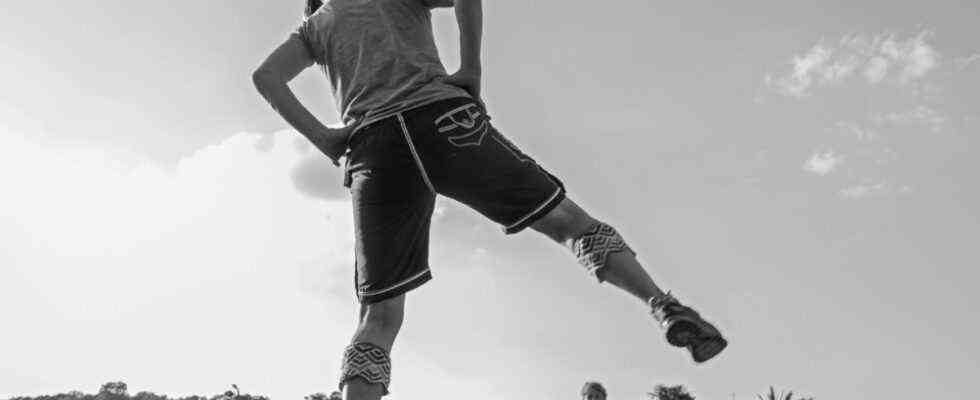You really don’t see that every day: in the middle of Munich’s Theresienwiese, a large group of women is performing gymnastic exercises, a workout, the instructor wears sports pants that look like short lederhosen, and Loferl to go with it. In the photograph that captures this scene, the young woman looks as if she is performing the dance of the funny Holzhackerbuam in an aerobics variant. The photographer Ursula Zeidler captured this scene with an ease that is typical of her. She always approaches an event quietly and unobtrusively, only to press the shutter button at exactly the right moment. Like here in this photo, which she has given the title “Wiesn-Wadl-Workout”, which congenially underlines the message of the picture with a pinch of irony. They are not interested in the big sensations, but in the peripheral scenes, which often reveal more about people than anything loud and screeching.
“When I take photos, I want to take myself back,” says Zeidler. This corresponds to the nature of the artist, whose presence is often not even noticed. Like the other day at the Bread Festival in Tacherting, where she quietly and inconspicuously captured scenes that in the end reveal more about the event than the most lavish documentation.
Photographer Ursula Zeidler
(Photo: Ursula Zeidler)
The photo with the women doing gymnastics is part of a photo series about Munich’s Theresienwiese that Ursula Zeidler is currently showing in the Photo Museum in Burghausen. For two years she observed what was going on at the famous place when there was no Oktoberfest, no Tollwood and no giant flea market going on there. When she started the one-year project in April 2019, Corona was not yet an issue. Then the pandemic broke out in February 2020, and Zeidler extended her observations for another year in order to document this exceptional situation as well. “I wanted to see what the people on the 42 hectare site are doing in times of calm.”
Theresienwiese, April 2020
(Photo: Ursula Zeidler)
First she photographed the Theresienwiese from the tower of the Paulskirche. The oval of the former horse racing track, where the first Oktoberfest took place in 1810, can be clearly seen in the panorama picture. Observing the Theresienwiese when it resembles a steppe, so far only few have come up with this idea.
Zeidler photographed walkers and cyclists, skaters and surfers, people who play sports, make music, read and relax with a picnic. In the pandemic, the demonstrations were added, Zeidler’s pictures show how the Theresienwiese became political again, as so often, around 1918, when the revolution began here.
With her own gaze she captured moments of freedom, joie de vivre and colorfulness, a mélange that came naturally without the Oktoberfest. What is shown is not always spectacular, but it is often enigmatic and funny, and all in all a unique document.
Gymnastics at the base of the Bavaria, January 2021
(Photo: Ursula Zeidler)
Ursula Zeidler, born in Ratzeburg in Schleswig-Holstein in 1946, learned her trade in the 1960s at the Bavarian State School for Photography in Munich. This was followed by her first stay in Ireland, where she had her first exhibition in 1968 in Dublin. For many years she then worked as a photojournalist who worked abroad and followed her local environment with interest. In 1983 her exhibition on the Haidhausen district, where she lived for many decades, was on view in the Gasteig in Munich.
Two women in front of a department store in Haidhausen, 1980
(Photo: Ursula Zeidler)
In 2004 she moved with her husband, the artist and author Fritz Dumanski, to an estate near Taubenbach in the Rottal, where she has found a real home. “Here I feel like I’m always on vacation,” she says.
In addition to journalism, she began to focus on portraits. For example, she photographed couples of all stripes, mostly in their living and living environment. She stated: “The things that accumulate as the precipitate of a long relationship usually reveal as much about the people as their expressions and their gestures.”
Irish couple 1968
(Photo: Ursula Zeidler)
The “Theresienwiese” builds on her earlier series “Moments”. Even then, she demonstrated her sense of the subtle comedy of a situation, of the curiosities of everyday life as well as of the tender aspects of life. For example in the picture in which a boy of a bride in a white dress excitedly shows a pile of horse droppings, which visibly touches him more than the wedding.
Perfect boy world: Leo and Finn
(Photo: Ursula Zeidler)
One cannot foresee such motives. Ursula Zeidler has this sense, and she handles it with ease. No one is ridiculed or exposed in their photographs. On the contrary: It shows the people in their wishes and joys, and if need be, also in their imperturbability, such as two elderly women in Haidhausen, a couple in Ireland or the locals in traditional costumes, who due to the lack of a Oktoberfest tent at the foot of the Bavaria completely celebrates his Oktoberfest alone.
Oktoberfest starts without Oktoberfest, September 2020
(Photo: Ursula Zeidler)
Ursula Zeidler’s photos show what everyone knows with a completely different nuance, but that is precisely what gives great pleasure when looking at it.
Ursula Zeidler, Munich Freedoms, Two years Theresienwiese, until November 7th, House of Photography, Dr. Robert-Gerlich-Museum Burghausen, Tuesday-Sunday, public holiday 10 am-6pm. Ursula Zeidler offers a guided tour on October 22nd (7pm) (Tel. 08677/4734).

